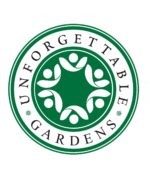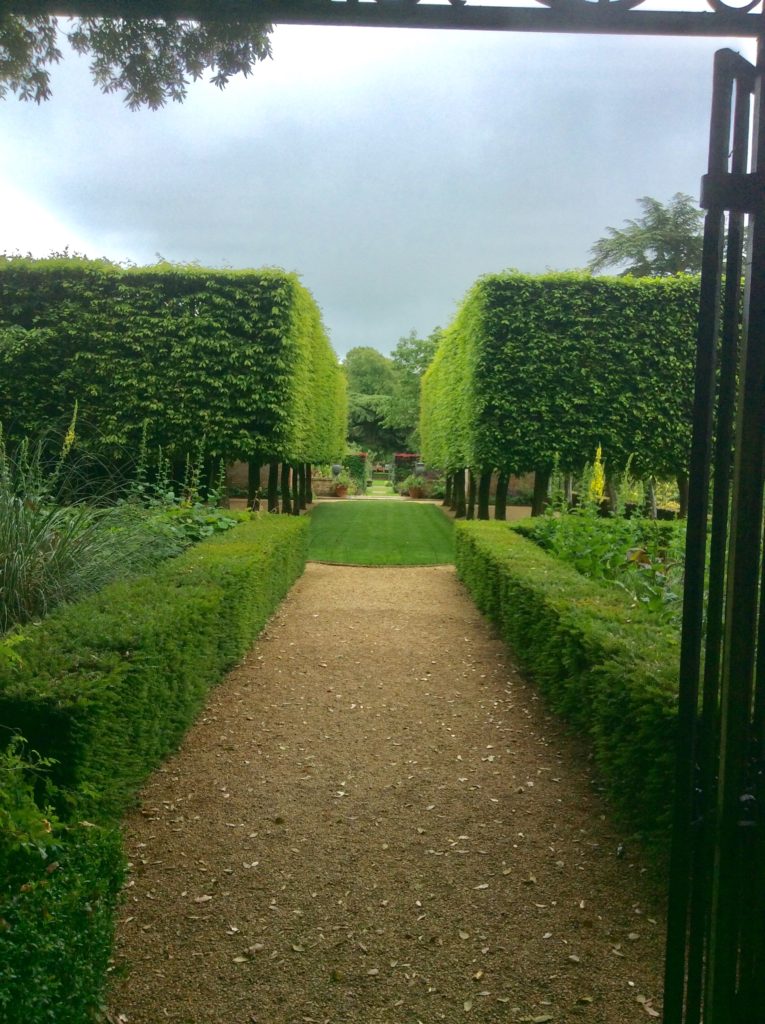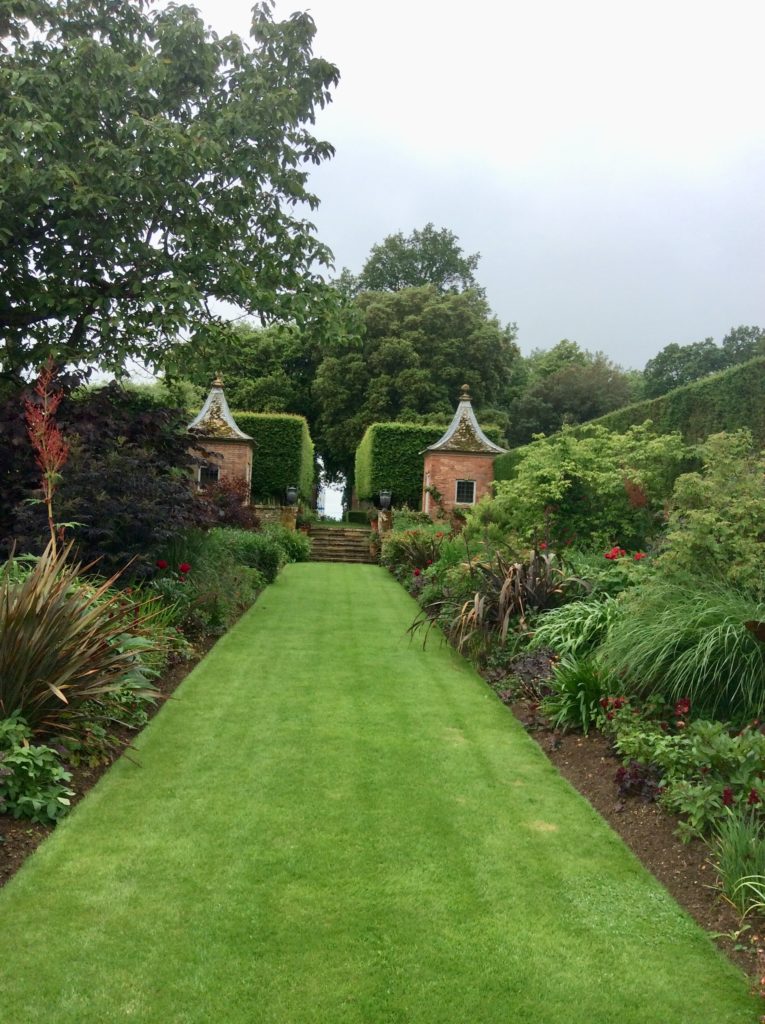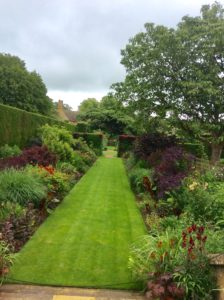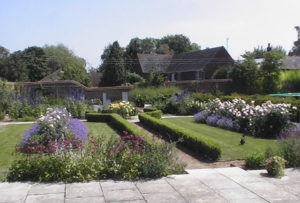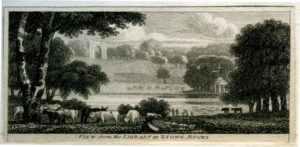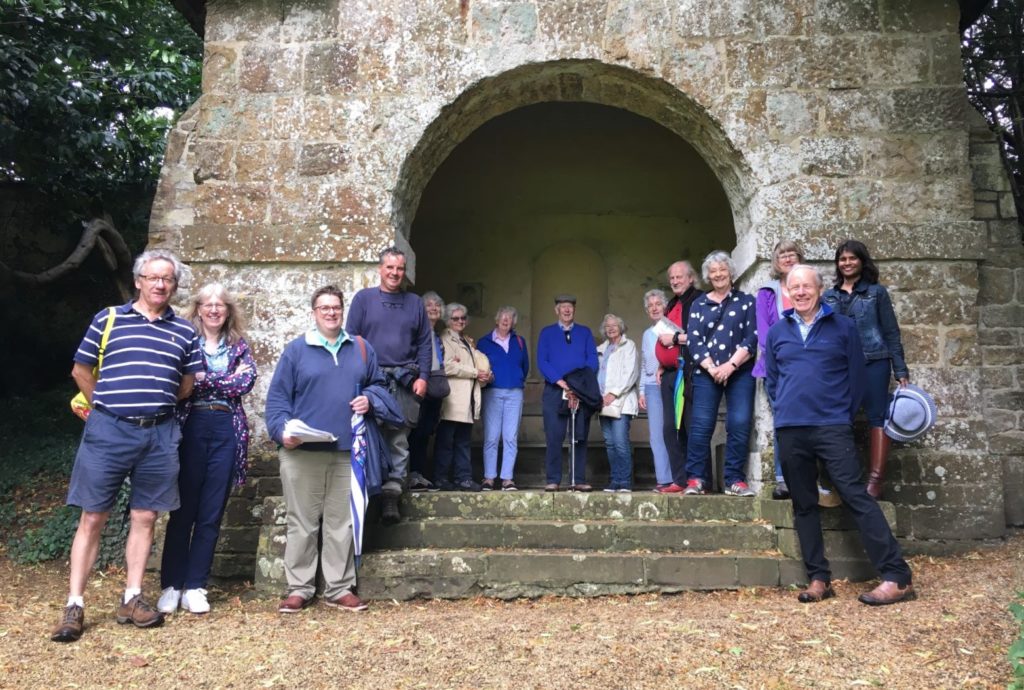
Did you book a visit to a garden?
In this edition of the Newsletter we are celebrating the return of the Buckinghamshire Summer Visits to a wide range of gardens and, parks and green spaces. Rosemary Jury has organised the sun to shine, not lost anyone and had tea provided where possible. There is still one more visit an early evening walk at Stowe on Wednesday 22nd September which you can book on line
Rousham Park, Sunday 1st August
A group of BGT members were very lucky that Charles Boot made one of his rare forays out of Aylesbury to guide us round Rousham Park.
Robert Dormer employed Bridgeman to lay out the gardens and when General James Dormer inherited from his brother in 1737 he saw the garden as an ideal setting for his antique statues. The General commissioned William Kent to naturalise the garden.
Charles led the walk following the route laid out by James Dormer to show the gardens to visitors; at each point he wove a description of the garden taken from a letter written by John (Mac)Clary, the gardener, to Sir Clement Cottrell , a cousin who inherited from James Dormer in 1741. This is a delightful description framed as a plea to the family to visit, and a reminder of ‘what a place Rousham is’.
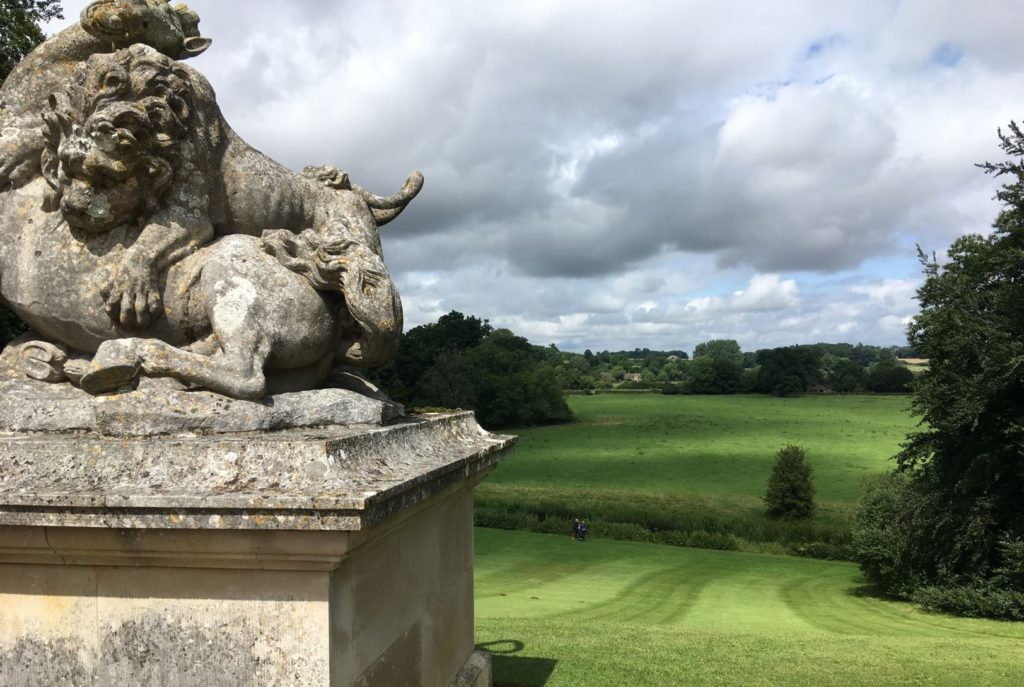
After picnicking under the Praeneste arcade, 80 feet long, and formerly fronted by a balustrade, we started the walk on the Bowling Green, where the statue of the Lion leads the eye out over the concave slope to the water meadows beyond the Cherwell. Rousham benefits from the land beyond which does not form part of the estate. Many of the views looking out towards the Eyecatcher, on the far hill, and the Gothick cornmill have been screened by trees that have grown, and the Eyecatcher itself is now set against trees where it would have been a bare hillside. The statues along the river look outwards but there are two points by the river where the eye would have turned the other way to the Praeneste and the theatre.
We turned left and looked out over the roof of the Praeneste, seeing the same view as from the top of the great slope. We walked to the Palladian Gate skirting the paddock, bounded by a ha-ha dividing it from the gardens, which at the time of Clary’s letter contained ‘two fine Cows, two Black Sows, a Bore and a Jack Ass’. From there the serpentine walks leads down to the river with the Heyford bridge to the left.
Where there are now laurel hedges Clary describes flowers such as honeysuckle, lilac, roses and syringa intermingled so that they looked as they were springing from the evergreens.
Walking back along the river bank there is a grove of tree to the right, prompting one to view the river to the left and then at the end of the trees to look up to the right through Venus Vale where Clary is also very admiring of the fountains that used to throw up jets of 50 and 30 feet, drawing the eye up the slope towards the figure of Venus backed by evergreen trees.

At many points along this walk there are structures, a pavilion, garden seats, a pyramid and places to take in the views. From the pyramid, the views of the river curving up stream to the bridge would have been idyllic when there was less greenery to obscure the view.
Beyond the pyramid and a spring, the path leaves the river and leads up the slope to the door into the walled kitchen garden where the 12 foot high brick walls made the air several degrees warmer. Beyond the kitchen garden lies the pigeon house garden with a parterre, access to the church and finally to the dairy yard. From this yard a gravel path leads to the right round to the former entrance to the house, and left to the stables. Our final extract from Clary’s letter praised ‘as pretty a set of pigg Stighs, as aney is in England’, and described a hen turkey with 18 young, 24 fine chickens ready for the spit and others nursing 66 babies and no less than 40 ducklings swimming after the old ducks. Clary then switches from this picture of avian abundance to an afterthought about a place in the gardens where you can see four counties and ten parish churches.
It was a perfect day for a guided walk as the rain had stopped and it was warm with a slight breeze and clear views across the valley. Charles was an informed and skilful guide and also drew on work by Mavis Batey to supplement Clary’s description and his own knowledge.
Liza Wormall
Buckinghamshire Gardens Trust Council.
At our AGM on the 30 October 2021 there will be a few changes in council members. We are looking for at least two new council members to take on roles as we currently require a Vice Chair-person and at least one Trustee.
We also need members who would like to help with the organisation of our 25th Anniversary events.
If you would like further details on any of these roles please contact Claire de Carle. If interested in the role of trustee please contact Claire de Carle for a copy of the charity articles.
Contents
John Nash and the Dovecot 1-2
Research & Recording Report 3
C19th Brick Kilns to be restored at Great Linford 3
Gardens across the Pond, Great Longford, 4-5
Pennsylvania . USA
Durability Guaranteed-Mrs Coade & Stowe 5-6
Gardens through the letterbox: Kabul 7
Stoke Poges Memorial Gardens 7-9
A Welcome to Chiltern Heritage Orchards 10-11
Gardens through the letterbox: Caserta 11
Valerie Finnis: Women in Garden History 12
Maud Grieve: Women in Garden History 13
Weeding Women: Women in Garden History 14
Margery Fish: Women in Garden History … 14-15
Dates for your diary 16
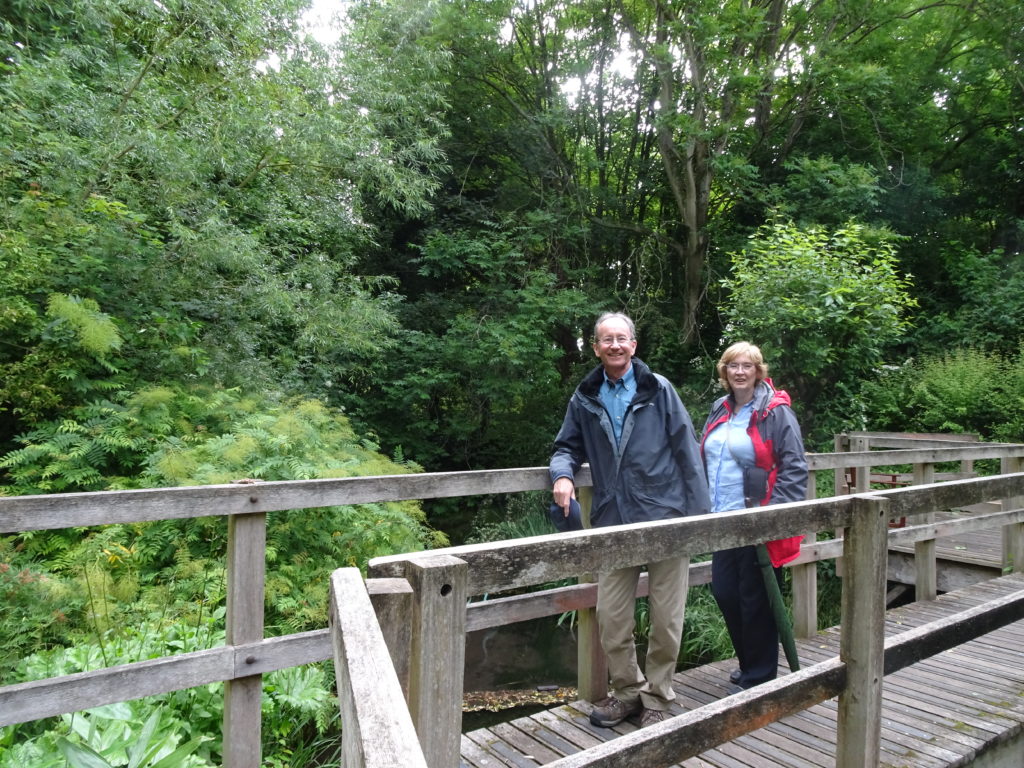
Bledlow Manor and The Lyde – Tuesday 6 July
Bledlow is the home of Lord Carrington and the centre of the Carington Estate. On a sunny and showery day 37 Trust members and friends met in the farm courtyard just south of the Manor House grounds for an introduction by Lord Carrington. In a witty, affable and self-deprecating manner, Lord Carrington described how his father and mother had settled in the splendid house in 1946, sharing it at first with the last of a long line of tenant farmers (the main family seat had been Wycombe Abbey). Lord Carrington related how they gradually planted out the surroundings of the house, quoting his mother: “Oh, Peter, not another field!” Lord Carrington then apologised for cutting his introduction short because he was due to make a contribution to a Lords debate on Zoom, but gave us free rein to wander and enjoy the gardens and The Lyde which he ensured was open for us.
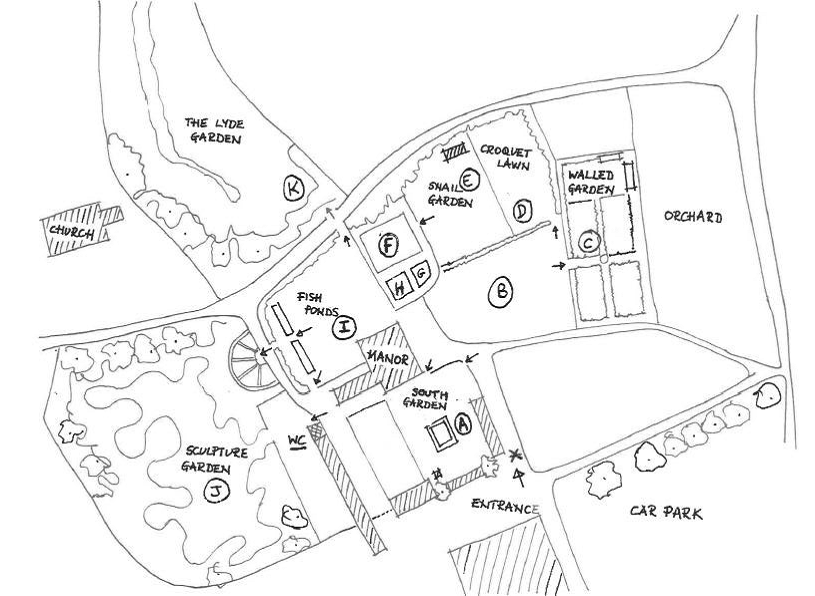
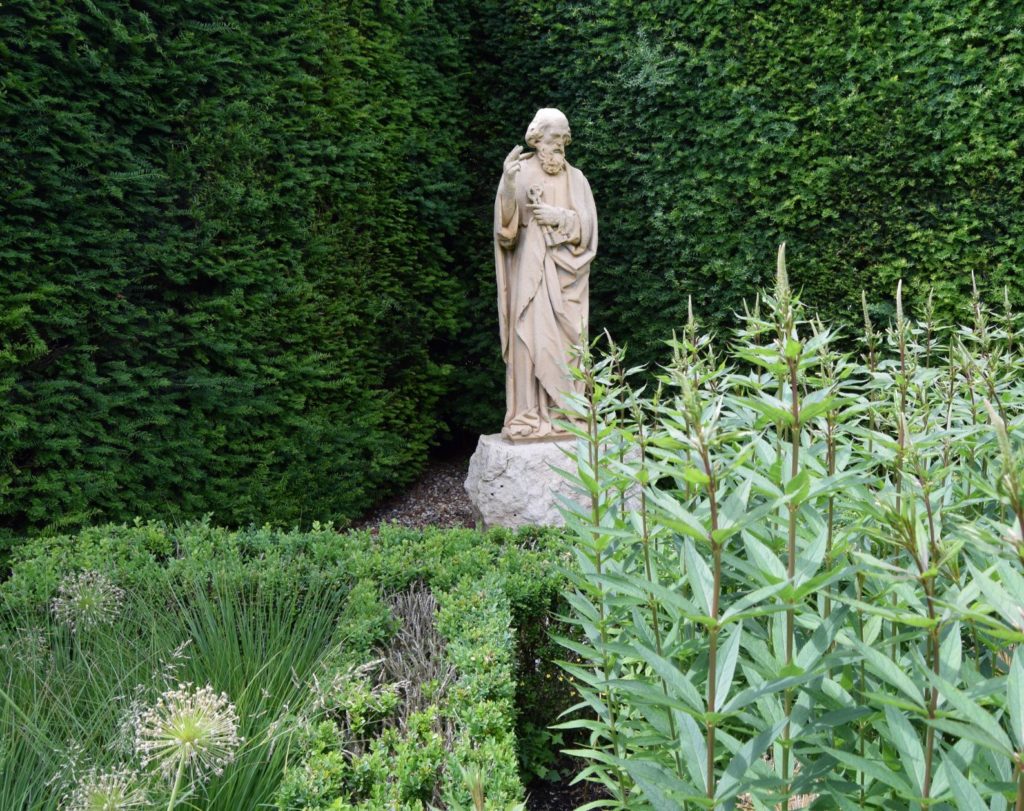
The Manor House stands on the south side of the village street, almost opposite the Parish Church, and dates from around 1670 but was altered in the early 18th century. Large sash windows were inserted in the early 1800s when the Caringtons first acquired it. The formal gardens include a splendid old walled garden, given over to vegetables, cut flowers and trained fruit trees, all centred on a deep green octagonal wrought iron gazebo planted with pink roses. Further west, the ‘garden rooms’ laid out by Robert Adams in the 1970s begin with an enclosed croquet lawn and the ‘Snail Garden’ created from an earlier swimming pool enclosure with a large stone snail lurking in the planting as a humorous remembrance for the late Lady Carrington who regarded them as her principal adversary. Closer to the house are the Coracle Garden where the visitor feels wading knee-deep through rich planting with an interesting water sculpture, a small parterre with a statue of St Peter rescued from the Houses of Parliament and a further small garden centred on an armillary sphere. An open lawn on the north side of the house runs down to a sequence of rectangular ponds, beyond which is the formal drive from the village street and then the sculpture garden that with varied works of art, shrubbery, lawn and mature trees makes brilliant use of the contoured ground. It covers 2.5 acres and was laid out in 1991.
The only garden on the south side of the house was created after 1967 when fire destroyed a large historic tithe barn between the house and the farm. The area had to be reconfigured and Robert Adams designed a formal lawn running from the house towards a sunken pool with an earlier granary on staddle stones rising up dramatically beyond it and terminating the vista.
The Lyde is on the north side of the village street opposite the Manor grounds and occupies the site of three watercress beds in a steep defile. The garden was created in 1982 to designs by Robert Adams after the watercress beds stopped production, surrounding elms had succumbed to disease and the area had become overgrown. Shingle paths and steps lead round the defile using boardwalks with rope guarding where necessary to provide a choice of entrancing circular walks around the spring-fed pools. Recent abuse necessitated closure for remedial works including the provision of taller railings on the frontage to the village street.
Luckily most of the Trust visitors finished their tours before the heavens opened!
Geoff Huntingford
More information about the landscape at the Manor House, Bledlow can be found in the Trust’s Research and Recording dossier at:
https://bucksgardenstrust.org.uk/wp-content/uploads/2016/10/The_Manor_House_Bledlow.pdf

Great Linford – Sunday 11 July
The historic village of Great Linford is now a suburb of Milton Keynes and is located near the north-eastern edge of its built-up area. Between the Grand Union Canal and the old village’s High Street is the historic landscape associated with the Manor House (earlier: Linford Place), which provides much of the settings of the nearby medieval parish church and of the delightful late 17th century combined almshouses and schoolroom. The Milton Keynes Parks Trust (the charity that looks after 6000 acres of parkland and green spaces throughout the city) has won Lottery funding to restore the Manor’s landscape. The Parks Trust has kept our Gardens Trust up-to-date with progress. Following a visit back in July 2017, it was highly appropriate for Rosemary to organise a further visit to see the current situation for ourselves.
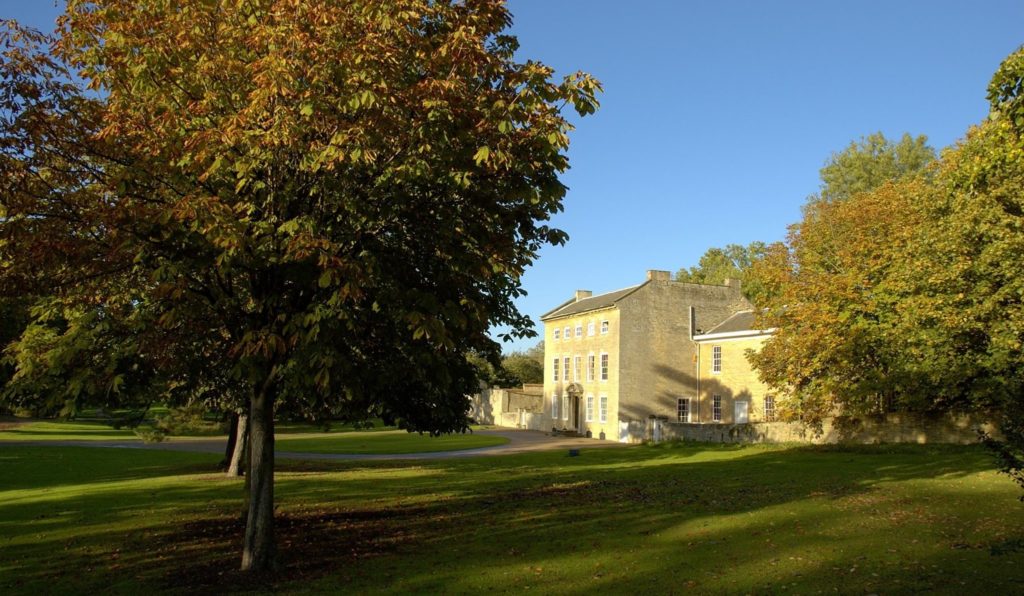
Accordingly, 33 Trust members and friends met at the arts centre west of the Manor and its detached stables on a sunny July afternoon. We were welcomed by Ellie Broad, Community Engagement and Activity Coordinator for the Parks Trust (also a member of BGT and looks after our social media), who introduced Andrew White, a Parks Trust volunteer, who had kindly come to help with the tour because of the size of our group. Before the group split into two to make their tours, Ellie paid tribute to dedication shown by the Parks Trust volunteers and explained the general layout of the landscape including the orientation of the detached stable blocks. She explained that they stand on the site of the original manor house.
We were shown the austere facade of the Manor which was begun at the end of the 17th century by Sir William Pritchard, a wealthy London merchant (and Lord Mayor) and refaced, extended and heightened by the Uthwatt family in the early 18th century. Moving north, Ellie’s group were taken to view the main works being carried out, the clearing and restoration of the sequence of ponds. Back in 2017 they were choked by trees and undergrowth but they have now been exposed along with much of the original stone facings of the ponds.
The Ordnance Plan of 1881 (published 1886) clearly shows the original arrangement of three ponds fed by a spring from the south. The northern pond was detached from the rest of the designed landscape by the construction of the Grand Junction Canal (now the Grand Union). We were conducted through the original ‘Wilderness’ on new walkways and were shown the veteran Lime tree on the way to further archaeological work to expose the original ha-ha on the eastern perimeter of the designed landscape. We were also taken to the site of a former Doric seat which originally commanded extensive views to the north. Passing back past the circular ponds and the almshouses, we gathered with the other group to enjoy tea and biscuits in the churchyard, kindly provided by the Verger’s wife.

Stephen Hitchings, the verger, completed our day by giving us a history of the church from around its exterior with wit and dry humour
It was exciting to view the impressive progress made with the clearing of the ponds and pleasant to see how many local families were out in the sunshine enjoying this attractive and historic location. Thanks are due to Ellie and Andrew White, and to Mr and Mrs Hitchings for the guiding and the tea!
Geoff Huntingford
More information can be obtained from The Parks Trust: www.theparkstrust.com/parks/great-linford-manor-park
Planning Update
With so many excellent contributions to the last newsletter there was no room for a planning update, but that doesn’t mean we haven’t been as busy as ever, with plenty of planning applications to review and even some fascinating site visits as well.
The consultations come in thick and fast but our concerns remain the same: we need to ensure that our comments are uploaded and incorporated into the planning process and there need to be more Heritage Impact Assessments being submitted as part of planning applications relating to registered parks and gardens. Too few applications bother to consider the gardens and landscape and only focus on addressing the listed buildings or AONB.
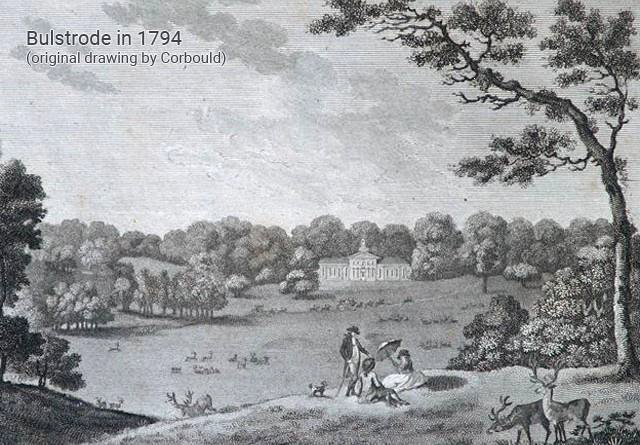
In the former South Bucks area we were fortunate to be invited to a site visit at Bulstrode Park to review revised proposals to demolish some modern buildings and convert the C19th house into a hotel with associated facilities. The Grade II* listed gardens at Bulstrode Park were developed by William Bentinck, 1st Duke of Portland, who was William and Mary’s collaborator and friend, and heavily involved in the creation of their gardens at Het Loo and Hampton Court. Much of his garden remains and is the best surviving non-Royal classic Dutch garden in the UK. We mostly welcomed the revised proposals, although we urged them to retain the Victorian greenhouse, either in situ or repaired and relocated to the nearest appropriate spot. Unfortunately our comments were not uploaded to the planning website nor referred to by the Planning Officer in his report, so we are waiting to find out whether our comments have been taken on board in the final plan.
Shardeloes, near Amersham, is also a Grade II* listed C18th registered park and garden and woodland with work by Nathaniel Richmond and Humphry Repton, surrounding an C18th country house, with remains of a formal early C18th layout in the park, possibly by Charles Bridgeman. We have recently objected to the creation of a new agricultural track which involves hard surfacing in a currently undeveloped meadow.
When applications involve new domestic buildings or extensions to existing ones, one of our major concerns is light reflection and emittance, particularly where the proposed structure is heavily glazed, and we recently objected to the creation of a heavily glazed garden room in the grounds of a residential property overlooking Latimer Park.
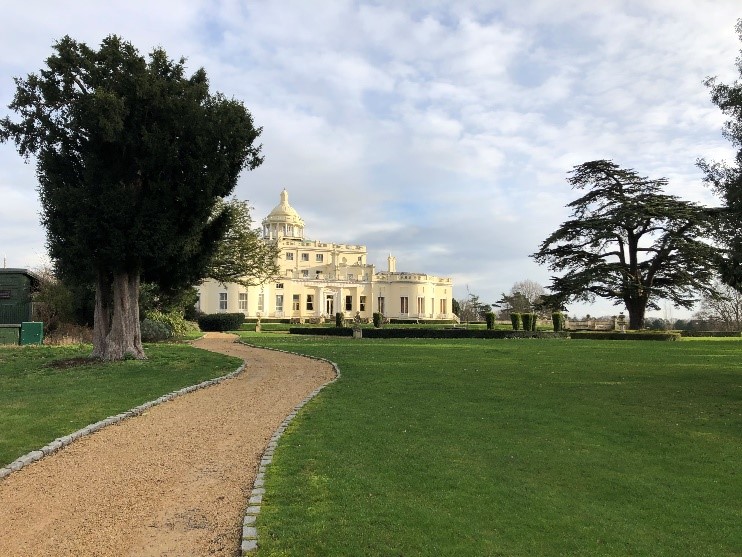
Our February planning report detailed our encouraging site visit to Stoke Park near Stoke Poges, where we were invited by the owners to comment on extensive proposals to increase the leisure facilities at their luxury hotel. We were delighted when our suggestions were incorporated into their subsequent planning application. However, the entire site was subsequently sold to Reliance Industries for an eye-watering £57 million and the golf club and leisure facilities are currently closed. We are aware that BGT members are concerned about the future of the site, but the previous owners are still involved and provide us with regular updates along with reassurance that the intention is to restore rather than change further. We anticipate a further site visit in the autumn.
In the Aylesbury Vale district there has been a resubmission for 130 houses near to Stowe – the submission is extensive and we have asked the planning authority to provide more direction as to what we need to review. In the meantime, we stand by our previous comments.
At Stowe no comment was made on two applications by Stowe School: one is the internal refurbishment at Chatham House and the other is the construction of a kitchen biodigester in an internal courtyard – neither damages the landscape gardens. However, we are working closely with the Gardens Trust to respond to a complicated planning application for a new Design and Technology building at the school. There is no objection to the principle of new buildings to support the school’s educational requirements, but the location has to be carefully considered in such a significant landscape. In this case the previously undeveloped location chosen will be highly damaging to a key area of Lord Cobham’s early work with Charles Bridgeman dating from the 1720s.
Another forthcoming site visit in the diary is to Lodge Farm near Wotton Underwood to review an application for a single-storey side extension. We were delighted to hear that an appeal for the installation of 22.50m-high engineering column also near Wotton has been refused, helped by our comments.
At Mentmore we had no comments on proposals for a minor alteration on a new house. However, had we been consulted back in 2016 when the original planning application for the new house was submitted, we would have objected to it. It is indicative of the degree to which planning authorities consult us more regularly now that we see so many applications for minor tweaks and alterations to structures that we might have strongly objected to if we had been consulted in the first place.
At Waddesdon we have supported alterations to Dairy Cottage but recommended that a Heritage Impact Assessment is carried out with regard to proposals to demolish three barns and replace them with a single large structure for a brewery company. Again, we have no objection to the proposed structures but it is light emittance and reflection in this significant landscape that raises concerns.
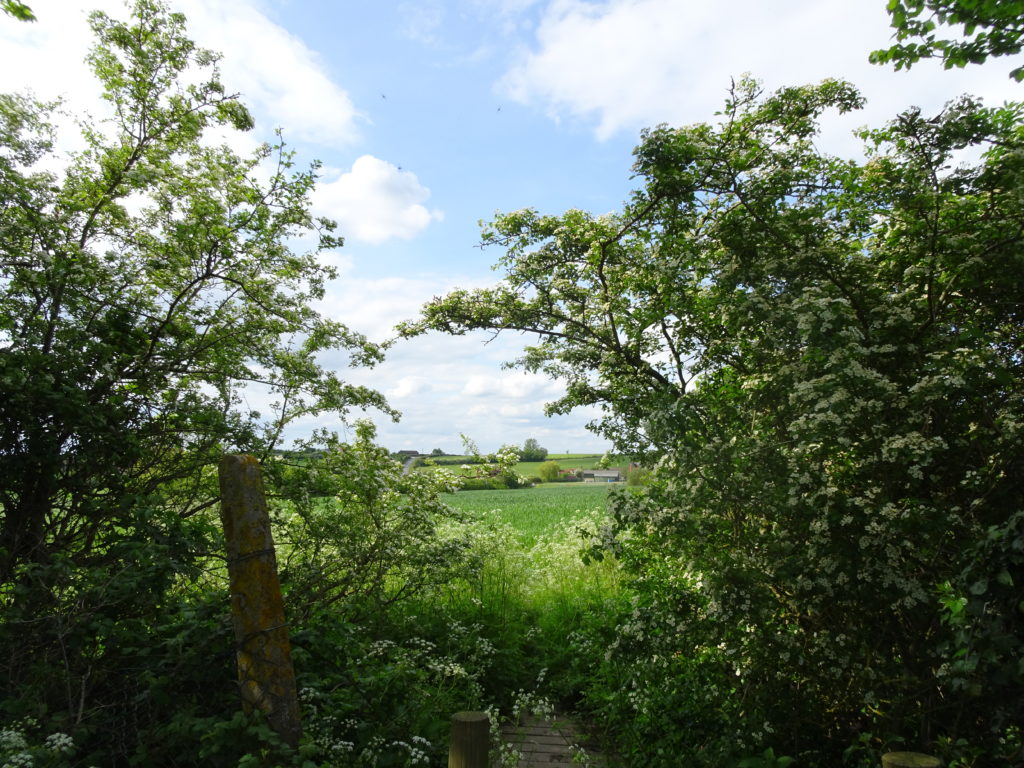
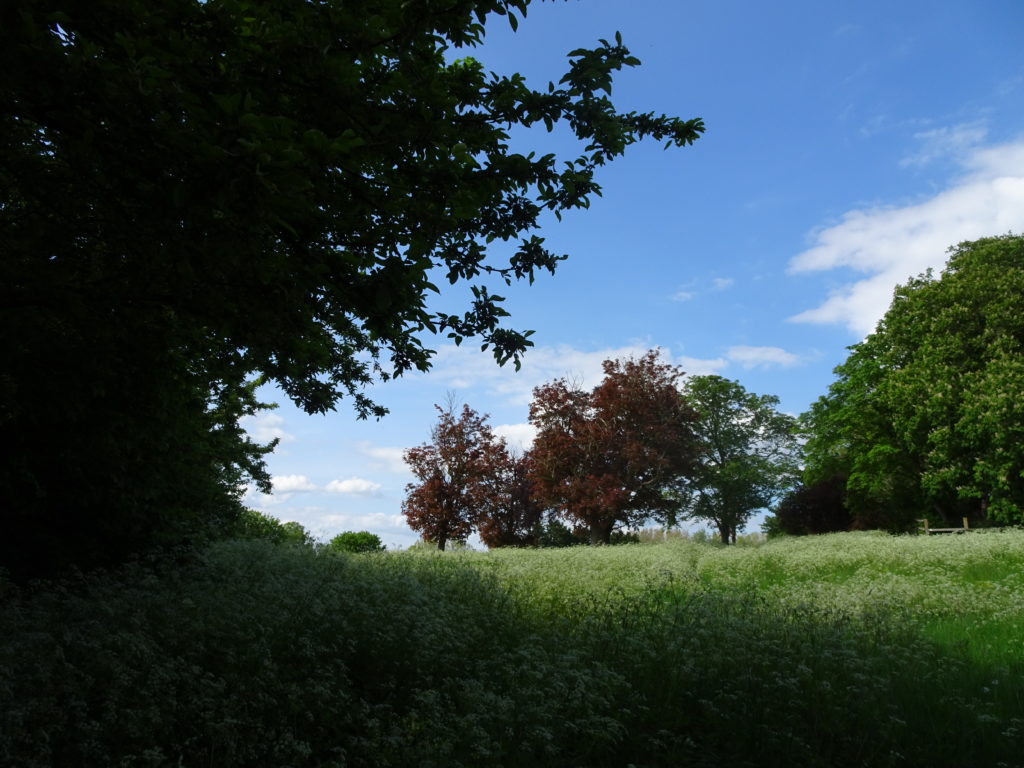
Another fascinating site visit was to the landscape surrounding Grendon Hall prior to a planning application being submitted for a substantial increase to the size and capacity of Grendon Prison. Unfortunately the site is not listed but you can find out more about the history as our Vice-Chair, Claire de Carle, has written an excellent report which is on the ‘Locally Important Sites’ page of our website. We are currently working on a robust response to the proposals
In the High Wycombe area we have supported an application for improvements to external lighting at Wycombe Abbey but, in response to an application for a new energy centre at Wycombe Hospital, we expressed concerns about the size and potential visibility of a very large chimney stack.
Finally, around Milton Keynes we have been consulted on a small application for a property at Gayhurst and a really large application for hybrid mixed-use development either side of the A509 near Newport Pagnell.
Thankfully, our wonderful team of researchers prove helpful when Sarah Rutherford or I are unable to get involved. Jill Stansfield recently joined an online meeting about the future of MK and updated us as follows:
“This is MK Council’s planning department’s opportunity to update consultees on developments, changes etc. There is a new structure in place which will improve project management capacity and the ability to plan infrastructure requirements in line with the 2050 growth strategy.
2023 is scheduled for consultation on the new draft Local Plan, with the final draft Plan scheduled for 2024 and the new Plan to be adopted in 2025. For the next 12–18 months they will be working on evidence-based studies including mass transit, carbon/climate, housing, employment, open space etc. Supplementary planning documents so far are the Health Impact Assessment (3/21) and Biodiversity (6/21). Later in 2021 they will focus on carbon reduction and air quality. All of this is expected to be the subject of consultations. Housing delivery has been strong over the past three years in comparison with neighbouring authorities.”
We are very grateful to Jill for doing this, especially as she is more familiar with Milton Keynes than we are. There are occasions when a flood of large applications come in and Sarah and I struggle to fit it in around our day jobs. For some applications we cannot even get involved as it would be a conflict of interest. So, as you might imagine, we are tremendously grateful for all of the support and the research offered by our Bucks Gardens Trust colleagues.
Finally, Claire de Carle and I have been involved in an ongoing consultation regarding the Local Nature Recovery Strategy.
Jo Mirzoeff
I often visit special places and wish I lived nearer to them to make visiting through the seasons easier. However, when you do live close to somewhere special there is a danger of failing to appreciate it properly. I live five minutes away from the Grade I Listed gardens at Cliveden which I have visited so frequently that I probably take for granted how special they are and how lucky I am. I am always pleased to have the opportunity to visit with a friend who has never visited before and relive seeing and wondering at the gardens for the first time through their eyes.
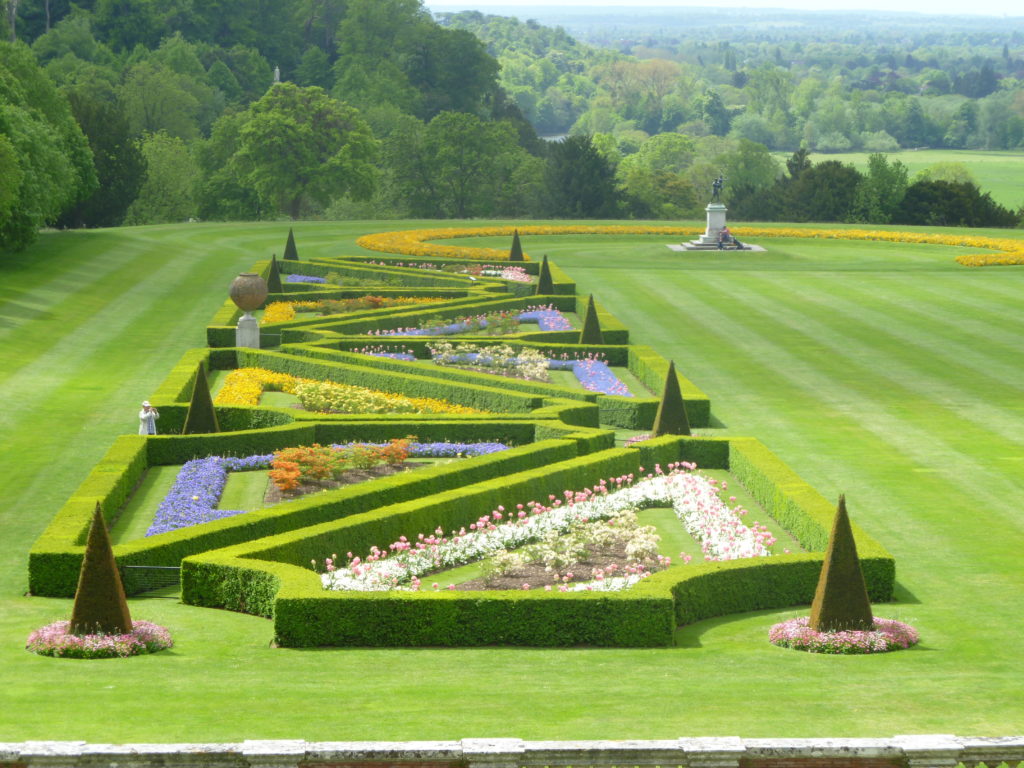
The real ‘wow’ for me is the view from the terrace over the parterre and on to the River Thames far below, I think it is the most stunning from any great house I know. Whenever I visit the interior of a stately home and enter a room I make straight for the window to see the view – I would love to wake up in a bedroom overlooking this view, what an uplifting start to the day. When standing on the terrace my mind will stray to all those going on the grand tour and bringing back works of art – I can understand paintings and sculpture but a balustrade? William Waldorf Astor brought a balustrade from the Villa Borghese in Italy in 1896 and erected it at Cliveden beneath the terrace at the top of the parterre. I love the fact that he also imported snails which were living on the balustrade. Apparently, they truly do travel at a snail’s pace, 25cm a year and have taken over a hundred years to colonise stonework 55 metres away.
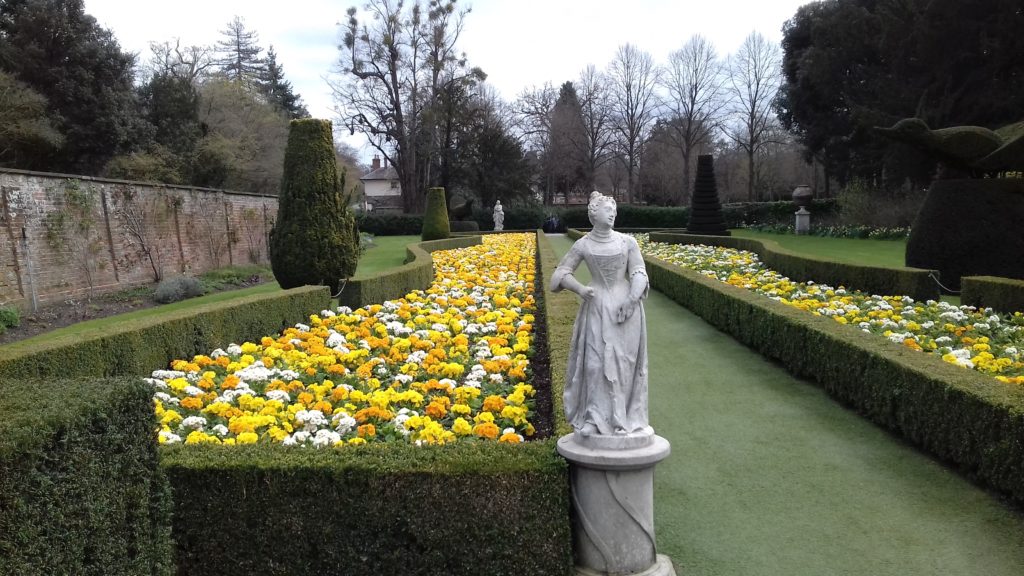
Apart from the view, the other wonder for new visitors is the scale of the gardens – 376 acres in total with about 100 acres being formal. It has a series of secret gardens set within the formal landscape. The Rose Garden recently restored after a few years as a herbaceous garden. The Long Garden which now contains spectacular displays of colour in the formal beds but sadly now with artificial grass down the centre pathway to cope with the concentrated footfall. The War Memorial Garden, originally conceived as an Italian Garden in 1902, was used as a cemetery for those who died during the First World War at the military hospital that the Astors opened at Cliveden. Finally, the Water Garden created by Lord Astor – I do wish they could do something about the pipework visible in one of the ponds, even though the ducks enjoy sitting on it.
I have so many memories of such a special place, the wild daffodils in the Russian Valley, walking in the woods and seeing snowdrops and bluebells. As a child I loved the Tortoise Fountain and the stepping stones in the Water Garden. I mustn’t forget the Fountain of Love, thankfully still standing after a driver from the Hotel, which now occupies the house, drove into the pond which surrounds it one winter’s evening recently.
For many years I watched the upper terrace crumbling away until the National Trust sold the former site of the Canadian Red Cross Memorial Hospital (formerly the Military Hospital) which gave them the funds to carry out the substantial necessary repairs. I wonder what the Duke of Buckingham and his architect William Winde would have made of the large slide that was erected on one side of the stairway from the Upper Terrace while the restoration work was in progress. The National Trust made some extra pennies by charging those so inclined to use the slide to access the lower terrace.
Unfortunately, like so many places Cliveden has suffered during the current pandemic. Staff have been reduced and, almost more importantly, volunteers have not been allowed, so for the first time for years the formal parterre has not been filled with colour; but it is returning and hopefully I will enjoy many more visits to this very special place.
Jane Bailey
Gardens through the letterbox
Postcard June 2021 from Hidcote, Gloucestshire
Dear Bucks GT,
A treat to visit this iconic garden which I know well. Primarily I look for some of the fine trees such as Cedrus Libani, the cedar of lebanon and the Aesculus Indica a splendid Indian Horse Chestnut which was in full flower. To my delight also in flower was Robinia X Ambigua Decaisneana, a locust tree with its large racemes of pale pink flowers and a great Pinus Radiata, the monterey pine. I enjoyed seeing the more unusual Hornbeam Carpinus Turczaninowii from the regions of North China, the Korean Peninsula and Japan which was introduced to Britain in 1914 by Plant Hunter Reginald Farrer.
Our visit to the famous “Garden Rooms” in late June, was well organised with Covid risk very low so you could escape from other people in the grounds. This garden was designed by the owner Lawrence Johnston from 1907. It was based on the ideas of the renowned garden landscape architect Thomas Mawson from Lancashire who made his home in Windermere in the Lake District. We have visited one of his gardens at Rydal Hall near Ambleside in Cumbria where William Wordsworth lived from 1813-1850, we have great memories of our visits.
Hope you enjoy the photographs I took of Hidcote. Regards Michael
News from the Research and Recording Project
Buckinghamshire Council Local List Project
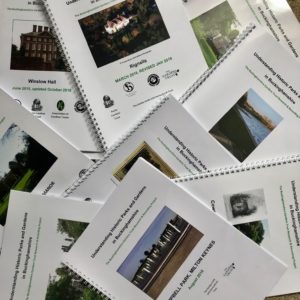
In February this year, the UK Government announced the results of the selection process for unitary authority local list projects. The successful councils would secure some of the £1.5 million pot of funds to enable them to embark on a pilot ‘Local Heritage List’ campaign. A total of 22 authorities were selected and Buckinghamshire and Milton Keynes were both on the list.
In the last few months members of Buckinghamshire Council HER (Historic Environment Record) team have been working tirelessly to get this project of the ground. The research and recording project has had a close relationship with the HER and in particular Julia Wise since its inception and we were keen to support this new project. Added to which we could offer a body of experience gathered over the last eight years and of course we already have a team of very capable trained volunteers.
Sarah Rutherford and I, alongside representatives from BAS have been invited along to bi- weekly ‘teams’ meetings online about the project. The HER staff have been working hard on a new website for the project which is to be launched shortly, they will also be organising events and a series of on-line lectures for later in the year. The object is to engage with local heritage groups and members of the public as they will be able to nominate sites/buildings/gardens for possible inclusion on the ‘local heritage list’.
While we have achieved a huge amount during the last eight years, in fact we have managed to complete most of the ‘A’ list sites on the Register Review there are just 17 left to research (not including Milton Keynes) and of these 3 are earthworks. There are still a considerable number on the ‘B’ list to be looked at, around 200. The local list project is just the incentive we need to address these remaining sites. The reports will be shorter than previously and will not involve site visits at this stage the purpose being to identify those worthy of inclusion on the Local List by conducting a desk-based operation and filling in a pro-forma. We plan to use resources available online: The National Library of Scotland OS maps, Google earth and online list descriptions as well as the information that Julia can provide from the HER. This is something that I have successfully managed during the last year when site and archive visits have not been possible.
The hope is that this boost will take us a step closer to completing reports on all the historic parks and gardens of Bucks in the coming year, watch this space, I will keep you up-dated on our progress!
Further details can be found at
https://local-heritage-list.org.uk/buckinghamshire
Claire de Carle
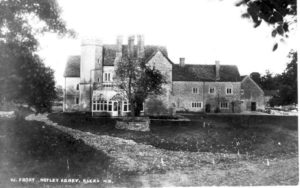
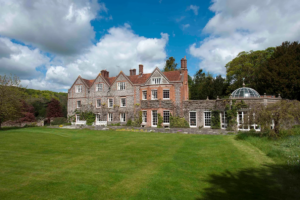
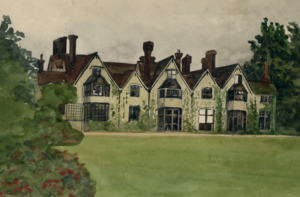

Champion Trees of Buckinghamshire –
Tomkins Park, Winslow
This is Champion Tree, Quercus Laurifolia ( Laurel Leaved Oak). This is has been registered in 2017 by Michael Hunt (Bucks GT member) as a member of The Tree Register of Britain as one of only 10 in Britain and is 7th tallest of them all. It is from the swamplands of Virginia to Florida in the USA. Introduced in 1786 it is semi-deciduous and of a dense rounded habit. It’s leaves are glossy green and interestingly varied in shapes from oblong and can be entirely or shallowly lobed, often three lobed. It’s leaves are from 2.5 to 12cm ( 1-5 inches long). Champion trees need open growing conditions, which can be found in places like parklands, old royal hunting forests and wood pastures. The National Tree Register is a unique record of notable and ancient trees in Britain and Northern Ireland and publishes the official Champion Tree database. In Buckinghamshire there are approximately seven of these trees which we will include in the Newsletter when we have the space.
Michael Hunt
St Dunstan’s Park, Monks Risborough
Monks Risborough sits beneath the Whiteleaf Cross and the Icknield Way at the foot of the Chilterns. The land here has always been predominantly arable with meadows and woodland and, being at the bottom of the escarpment, it is close to the spring line and a small stream runs through the village and between the church and the park. Many readers may have even visited St Dunstan’s Church and the adjacent St Dunstan’s Park which wraps around the churchyard and may have noted that a nearby road is called Place Farm Way, but probably concluded this is just another quaint little Buckinghamshire village. However, there is a fascinating history to discover here and the journey goes back a very long way.
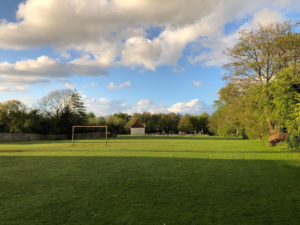
In 2013, an archaeological dig in St Dunstan’s churchyard (adjacent to the park) uncovered evidence of an Iron Age house and a large number of Roman finds which indicated a ‘reasonably wealthy Roman villa nearby’. (1) There was also a notable increase in finds from the 9th to the 11th century which brings us neatly to a most remarkable historical fact. Monks Risborough (or East Risborough as it was then known) is the oldest recorded ecclesiastical parish (2) in the country, as confirmed by a charter dated AD 903. This charter, written in both Latin and Anglo-Saxon, records that the estate of 30 hides was given by Athulf to his daughter Aethelgyth and, despite being the oldest charter, it is only a copy of an even earlier one lost in a fire!
By AD 994, the estate had been given to Christchurch Cathedral at Canterbury and was held by Sigeric, the Archbishop of Canterbury. It was briefly held by Aescwig, Bishop of Dorchester-on-Thames, as security for a loan and was then returned to Christchurch by King Ethelred in AD 1006. During the reign of Edward the Confessor, the last Anglo-Saxon King, the estate was held by Asgar the Staller on condition that it was not separated from the church. (3) Following the Battle of Hastings, Asgar had directed the military operations of the citizens during the siege of London but later changed allegiances and may have witnessed the Norman army as it passed by on the Upper Icknield Way. (4)
The Domesday Survey of 1086 records that the Tenant-in-Chief was Archbishop Lanfranc, who had been appointed as Archbishop of Canterbury by William the Conqueror, and the estate was assessed at 30 hides and there were 44 households made up from 32 villagers, 8 smallholders and 4 slaves. 16 hides and 2 ploughs were the Lord’s demesne and there were 12 ploughlands for the villagers, meadow for 6 ploughs and woodland for 300 pigs. (5) However, the Archbishop may have been the titular holder and the estate actually owned by the monks.
It has often been speculated that there may have been a monastery on the site to the north of the church (where the St Dunstan’s Park is now situated) which the Canterbury monks farmed and which gave the village its name ‘Monks Risborough’. The Ordnance Survey map of 1923 shows ‘Monastery (remains of)’, which might imply visible evidence and, in 2004, an archaeological investigation for a proposed churchyard extension revealed 10th century boundary ditches. However, it is now thought that it would have been a Manor and associated farm with possible access via the lane which runs between the church and the graveyard but no evidence that the monks farmed it themselves. St Dunstan’s Church itself dates from the 13th century although alterations and extensions continued throughout its history, and it probably sits on the site of an earlier structure.

Life for the average peasant in the Middle Ages is for the most part unrecorded, but here Monks Risborough (6) again makes the history books, albeit rather unsuccessfully. In 1336, the tenants had long-standing grievances and, well aware of their legal rights, sought to be released from their bondage by claiming that the manor was ‘ancient demesne of the Crown, and that they were not villeins but free tenants, able to dispose freely of their lands without licence from the lord.’ Unfortunately, the Canterbury Prior presided in person over the Manor Court and concluded that the tenants ‘held their land at the lord’s will by a base tenure. Several of the tenants were taken to Canterbury and there kept prisoners for seven years, until, having admitted their servile condition, they were permitted to return’. (7)

Control from Canterbury continued until 1535, when King Henry VIII sought to impose taxes on the church and ordered a valuation of all ecclesiastical property in England. (8) The manor of Monks Risborough was let out by the priory of Christchurch Canterbury and the valuation recorded a rent of £9 per annum with a further £25.8s.11d a year coming from the two mills and a further 60s from the woods. (9) By 1539, the Priory had been dissolved and the manor of Monks Risborough was finally separated from the church and sold in 1541 to Sir Francis Bryan and Thomas Lawe. By the 18th century, it was owned by the Earl of Buckinghamshire.
The square dovecote was built at some point during the 16th century. Dovecotes were used to house pigeons kept for food during the Summer and Autumn and the existence of such a structure denotes a religious or secular house of high status. (10) It is listed Grade II* and Historic England details its construction from ‘coursed rubble clunch with some flint and tile. Large dressed stone blocks at quoins. Pyramid tile roof, central timber entry turret with similar roof’. (11)

On the north-west elevation, there is a doorway under a chamfered semi-circular arch made from clunch which once had decorated carvings. It has been speculated that the door might have been a later addition or from an earlier structure on the site. Reused carved stones can be seen in local houses such as this blind tracery panel in the English Gothic style dated to between 1290 and 1400 AD, also made from clunch, and set into the wall of a 17th century cottage in the village. (12) Perhaps they and the dovecote arch were architectural features from a lost older but rather smart building?
The site therefore continued as a working farm and, as well as the dovecote, there are records of a tannery on the north side and watercress beds to the south and east. (13)
There was strong opposition to Enclosure in Monks Risborough and it was not until 1830 that it was finally confirmed in an Act of Parliament. A counter petition from residents resulted in a unique clause being included in the Bill to appoint a Special Commissioner for the poor, who were eventually allocated some fields to compensate for having lost their rights to gather wood once all the woodlands in the parish were granted to the Earl of Buckinghamshire. (14) The 1831 Enclosure map shows the access lane to the west of the church, an agricultural field to its immediate north, a collection of buildings forming Place Farm including the alongside the watercress beds and further watercress beds in the section which now runs alongside Dunsmore Avenue.
By 1841, the Census reveals that Place Farm is run by Mr William Rogers but, by the 1851 Census, his 65 year old widow, Rebecca Rogers, is living at Place Farm with two agricultural labourers running the farm. In October 1853, an advertisement in the Bucks Herald newspaper (15) gives us some idea of the site itself: ‘Desirable freehold, copyhold and leasehold for 700 years estates comprising the Place and Ham Farms, a Water Corn Mill, Cottage and Garden and Hatch Mead lands containing together about 114 (at MR only) acres whole estate producing a rental of £240 per annum’. We also encounter the Pauling family living at the nearby Ham Farm who will take over running Place Farm by the end of the century.
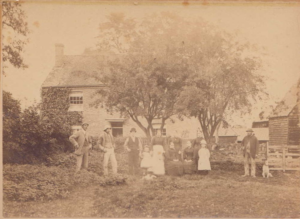
By March 1897, Leonard Pauling, tenant of Place Farm, had died but, at an auction in September 1899, Place Farm was sold by private treaty to the tenant, none other than Leonard’s widow, Isabella.
Isabella was still at Place Farm on the Census of 1901 with six of her children aged between 16 and 42 and the farm was clearly doing well, as, in October 1902, the Bucks Free Press announced the sale of farming stock including 200 sheep, 13 cattle, 12 horses, 7 ricks of hay, 6 corn ricks and 10 of wheat and oat straw at Place Farm. (16)
By 1911, Isabella’s son Albert and his family are living at Place Farm although Isabella is elsewhere in Monks Risborough. Albert died in November 1916 although the sale of the farm did not take place until October 1920 when it was purchased by the Hitchcock family.
The 1939 National Register (17) reveals William H. Hitchcock was a dairy farmer and he lived at Place Farm with his wife Jennie and their son, Bertram, a motor mechanic. Mr Hitchcock was interviewed around this time for an article on farming and Place Farm was described as ‘An ancient peace seems to linger there…, with the brown
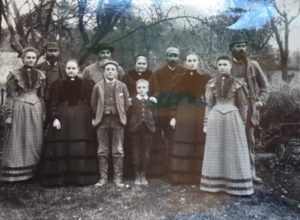
and white cattle grazing around…, the gold-roofed barns and gold of the haystacks catching the rays of the setting sun, the little streams running happily through the meadows and a distant rotund figure sitting quite still by the farmhouse door…’. (18)
In 1953, Mr Hitchcock was interviewed again by the Bucks Free Press about the possible compulsory purchase of the farm for housing development. He described it as ‘70 acres which he had farmed for 33 years as good farming land with a stream running through and one of the best farms in the county…, I don’t think the time will come when my land will be needed for houses’.
Unfortunately for the farm, that time arrived and planning permission was granted in 1962. By 1964, the estate agents Hamnett Rafferty were marketing ‘95% mortgages on detached, semi-detached houses and bungalows from £3,995 freehold at Place Farm’. (19) It seems that some of the original farm buildings were retained for storage until the estate was finished. At some point during the mid-20th century, a large opening had been made on the east elevation of the dovecote, perhaps originally for cart storage, but this
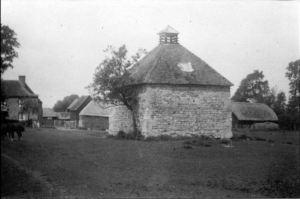
was later filled in with Purbeck limestone.
The 1970 Official Guide to Princes Risborough detailed how St Dunstan’s Park came into existence: ‘This land which was recently acquired by the Parish Council has an acreage of 4.09 acres. The Parish council with the aid of grants from the county council has carried out extensive drainage and levelling works. It is intended to provide recreational facilities on the ground and the work will be phased over a number of years. The ground contains a Children’s Corner with slides and play equipment. (20) The creation of the park St Dunstan’s Park in the 1970s involved levelling the surface but there may be that further archaeological remains lie underneath. The playground equipment has been enhanced a number of times, the basketball court resurfaced and the football posts still provide for Saturday morning practice.
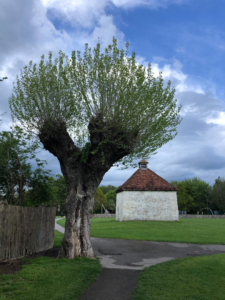
The Dovecote remains and, in 2015, a condition survey was carried out and the dovecote was returned to its historic appearance with lime wash, the traditional approach to protecting the stonework.A few old trees can be seen alongside or within the domestic gardens of the houses and the stream still separates the park from the church.
Jo Mirzoeff
References
1 Eyers, Jill & Watkins, Hayley, ‘More Than Six-Feet-Under: The Big Dig at St Dunstan’s Churchyard’, Chiltern Archaeology, 2013, p. 43
2 The ecclesiastical parish included Meadle, Owlswick, Askett, Cadsden and Whiteleaf. The charter is held at the British Library
3 https://opendomesday.org/place/SP8004/monks-risborough/
4 Turner, G. J., ‘William the Conqueror’s March to London in 1066’, English Historical Review, Vol. 27, No. 106 (Apr., 1912), pp. 209–25
5 https://opendomesday.org/place/SP8004/monks-risborough/
6 Or ‘Parva Risborwe’ (Little or Small Risborough) as it was also known
7 Nichols, John F., ‘An Early Fourteenth Century Petition from the Tenants of Bocking to Their Manorial Lord’, Economic History Review, Vol. 2, No. 2 (Jan., 1930), p. 300
8 1534 Act of Supremacy when King Henry VIII separated from Rome and, in 1535, Henry sought to impose taxes on the church and ordered the Valor Ecclesiasticus
9 https://en.wikipedia.org/wiki/Monks_Risborough
10 Huntingford, G., ‘Dovecote, Monks Risborough, Buckinghamshire’ (De Montfort University, 1997/98)
11 https://historicengland.org.uk/listing/the-list/list-entry/1125788
12 Eyers & Watkins, p. 13
13 Eyers & Watkins, p. 62
14 Turner, Michael E., ‘The Cost of Parliamentary Enclosure in Buckinghamshire’, Agricultural History Review, Vol. 21, No. 1 (1973), pp. 35–46
15 Bucks Free Press, Saturday 8 October 1853 (British Newspaper Archive)
16 Bucks Free Press, Saturday 11 October 1902 (British Newspaper Archive)
17 The National Register was taken on 29 September 1939 at the onset of World War II to compile information for Identity Cards and then later to issue ration books
18 Taken from an article ‘Farming Interviews No.6’ provided by the Princes Risborough Heritage Society, original source unknown
19 Hammersmith & Shepherds Bush Gazette, Thursday 26 March 1964
20 Princes Risborough Heritage Society
Photos @ Jo Mirzoeff unless otherwise credited.
With thanks to the Princes Risborough Heritage Society for their information and archive photos, to Councillor Alan Turner for further research, Geoff Huntingford for the loan of his assignment and to Norina Pauling for allowing me to use her family photos.
An Introduction to Garden History in 10 Objects: Study Day on Saturday 21st August at Stowe

This study day at the New Inn, Stowe held over from 2020 was well attended. Our first challenge was to try to identify the ten objects, some which were very strange. Claire de Carle took the role of David Marsh and gave an illustrated overview of garden history from the Egyptians to the present.

At the end of her talk we reviewed the objects and it was surprising how many we were able to identify, with discussion on the origin of the garden gnome creating an amusing pre-lunch chat.
In the afternoon Dr Stephen Wass MA, MCIfA of Polybion Archaeology gave an illustrated lecture on the latest developments at Stowe including new archaeological finds.
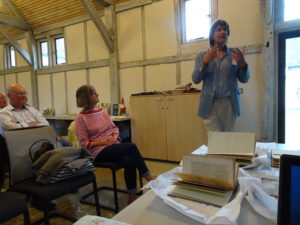
Stephen has been undertaking a series of archaeological investigations in the Stowe Landscape, including the Cascade, the Doric Arch and the approaches to the Rotunda. He updated us on these, revealing how the layout of various parts of the landscape have been adapted and changed over time.
Stowe had for many years been open for visitors as it is today and Claire brought with her some books owned by the Trust, the Benton Seely eighteenth-century Guidebooks to the Great Gardens at Stowe. A great reference source. You can see these guides on the table in the photograph above.
It was a most informative and interesting day and a big thank you to Claire and Stephen.
Gwen Miles
Buckinghashire Gardens Trust Subscription: amazing value with no increase since 1997!
Buckinghamshire Gardens Trust has not increased its subscriptions since 1997, the year of its foundation. In spite of an annual 2.7% inflation rate (Bank of England Inflation Calculations) the Trust has managed with some generous donations to maintain the original subscriptions. However, this is no longer possible and the Council have agreed that from April 1st 2022 we shall have to increase our subscriptions but only roughly in line with the inflation rate. So you are paying no more than you would have done 25 years ago! In fact generally less.
As some members like to update their bank account standing orders or direct debits in an ‘Autumn Update’ we thought that advance warning of increases would be useful. When increasing the rates we reviewed eight other local County Garden Trusts and we will still be one of the most reasonable in the country after the increases in April 2022.
Membership Subscriptions 1st April 2022
| Membership | New 2022 | 1997 | Inflation 2.7% to 2020 |
| Individual | £20 | £15 | £27.92 |
| Joint/Family | £30 | £20 | £37.23 |
| Single Life | £300 | £150 | £279.19 |
| Joint Life | £450 | – | |
| Schools/Societies | £25 | £25 | £45.33 |
A very big thank you to all members for paying your subscriptions on time. We do not have any membership subscriptions outstanding for 2021 and we continue to have new members joining. A joy for the Membership Secretary.
Gwen Miles – Membership Secretary
Profile of Gwen Miles
 My infancy was spent on Hayling Island, an idyllic time of beaches, beach hut, prefab dwelling, sailing and watching my parents gardening. My mother gardened and my father was the nurseryman specialising in fuchsia, dahlias, begonias and chrysanthemums. Show time, whether local or Chelsea with Brian Kidd (Portsmouth Parks), meant long hours, slim brushes, specialist boxes for packing and then peace and hopefully more Banksian Medals, in gold!
My infancy was spent on Hayling Island, an idyllic time of beaches, beach hut, prefab dwelling, sailing and watching my parents gardening. My mother gardened and my father was the nurseryman specialising in fuchsia, dahlias, begonias and chrysanthemums. Show time, whether local or Chelsea with Brian Kidd (Portsmouth Parks), meant long hours, slim brushes, specialist boxes for packing and then peace and hopefully more Banksian Medals, in gold!
The schoolgirl – just before the 11+ we moved with parents, two sisters, a dog, greenhouses and stock plants to a new house and a clay garden with five springs. The new school widened my horizons, and although I spent my time acting, taking part in sport and of course sailing at Hayling Island Sailing Club I managed to pass seven O-levels.
As a teenager my first job was at Barclays Bank in Emsworth, more sailing including the Round the Island Race in a Wayfarer, totally mad. Then a year taking three A-levels and working at Butterick & Vogue Patterns in accounts to get into teacher training.
1966 as a young woman it was Weymouth Teacher Training College to take the new BEd (Bachelor of Education degree) with Southampton University offering, as part of the history course, archaeology with Bill Putnam and Professor Barry Cunliffe. Roman Britain was the focus with digs in Dorset (lots of barrows, roads and villas), Cadbury and one summer as the researcher for Margaret Rule who was working on the garden at Fishbourne and learning to dive to excavate the Mary Rose.
Career woman: Chichester High School for Boys was my first teaching job, 800 boys, 80 men, 3 women staff and a farm. In 1971 I was the Censors Officer for RAF Thorney Island, local mariner and moorings (I could row a boat!). This led to meeting my future husband Peter, a pilot and the first of 18 moves and teaching at the Misbourne School with Derek Thrower as Head Teacher. Two years later a move to Germany, supply teaching and then head of lower school at Cheshire Middle School in Bruggen, including two moves and running a riding stables part-time while Peter was spying!
Life balance: 1978 back to the UK with moves to North Yorkshire, Lincolnshire, Bedfordshire, Oxfordshire and Buckinghamshire, two children, a printing business, eight teaching jobs (assorted) City & Guilds in Floral Design and Open University BA Hons degree. Peter refused a Denmark move to enable me to take up a senior post at Chesham Park School teaching Business Studies and English. Sailing continued at Bury Lake Mariners, Rickmansworth and involvement in its management for 25 years.
Experience and freedom: Semi-retirement in 1997 enabled holidays not in school time, our own home and a large garden, sailing, golf and running a floral design business and joining Buckinghamshire Gardens Trust research and recording team. I like a challenge and learning to run a website, write a Newsletter and indulge in my passion for research has been my experience since joining Bucks GT. Two grandchildren have arrived and being “GG” Granny Gwen is an absolute plus. What next?
In addition to ‘Profile of Gwen Miles’:
I’m sure that you will all have enjoyed reading this profile of Gwen (Miles) who since joining the Bucks Gardens Trust in 2017 has brought her considerable life experience to so many areas of our work, as Membership Secretary, Website Administrator, Newsletter Editor – even finding time to take part in our Research and Recording Project.
It is Gwen we have to thank for our now excellent website as it was she who insisted on its upgrading … and for the Newsletter that you are enjoying … Gwen’s Newsletters having kept us together and in touch during these past difficult months. So, a big thank you Gwen!
Rosemary (Jury), Chair
Buckinghamshire Gardens Trust Events
We have a new booking system that enables you to book and pay online by card. If you prefer to book via Rosemary Jury then contact events@bucksgardenstrust.org.uk
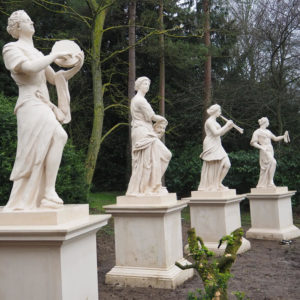 Wednesday 22nd September 6–8pm
Wednesday 22nd September 6–8pm
A Guided Evening Walk at Stowe with Richard Wheeler and Barry Smith, the Head Gardener.
Celebrate late summer and book a guided evening walk at Stowe to see the recently replaced statuary.
Open to members and guests £5.00.
Meeting: 6pm in former National Trust car park. Please take the Stowe school entrance and check in at the security hut; bring your National Trust card if you have one
Booking: ww.ticketsource.co.uk/buckinghamshire-gardens-trust
Saturday 30th October 2–2.30pm 
Notice of the Buckinghamshire Gardens Trust Annual General Meeting.
Agenda and reports will be published and sent to members in September.
New venue: St Mary’s Church, Church Street, Aylesbury, HP20 2JJ – 50 yards from the Museum.
Members: please book in: www.ticketsource.co.uk/buckinghamshire-gardens-trust/t-oxlveq
Following on from the AGM will be a talk by Richard Wheeler. Please book separately.
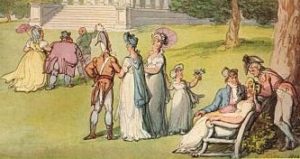
‘The Georgian Visitor: A Vignette of Garden Visiting in the Eighteenth Century’, Richard Wheeler’s talk
Richard Wheeler describes himself as a ‘Superannuated garden historian now practising under the heading Practical Garden History’. Meet members, friends and bring guests. Tea and cake included. Book and pay £10 per person www.ticketsource.co.uk/buckinghamshire-gardens-trust
Future Events for autumn and winter 2020–21
November talk at St Mary’s Church, Aylesbury
Christmas Gathering – to be arranged
January, February and March in planning. Delivery to be decided depending on COVID status.
Oxfordshire Gardens Trust
Zoom links will be sent just before each lecture takes place, please enter the ‘zoom room’ by 5.50pm for lecture links at 6pm. Register for each talk on EventCube: https://ogtevents.eventcube.io, £4 members (inc other GTs), £5 non-members.
Thursday 30th September, 6pm: Capability Brown at Radley: Rediscovering a Lost Landscape
Thursday 21st October, 6pm: Flora Domestica: A Social History of Indoor Pot Plants – Advolly Richmond
Thursday 18th November, 6pm: 20th-Century Gardens and Landscapes – Susannah Charlton
Thursday 2nd December, 6pm: Birds in our Gardens and Landscapes – A Seasonal Selection of Poetry and Prose – Jaqueline Mitchell, compiler of Birds: An Anthology
Celebrating 25 Years
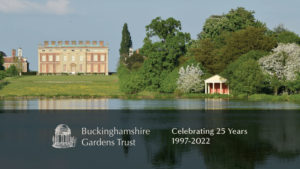 Claire de Carle and her 25th Anniversary team are putting together a very exciting events timetable for 2022 to celebrate the 25th Anniversary of the Trust. It includes a series of walks, visits to ‘Unforgettable Gardens’ and a celebration at one of Buckingham-shire’s outstanding properties. We will also have a special desk calendar on sale from October.
Claire de Carle and her 25th Anniversary team are putting together a very exciting events timetable for 2022 to celebrate the 25th Anniversary of the Trust. It includes a series of walks, visits to ‘Unforgettable Gardens’ and a celebration at one of Buckingham-shire’s outstanding properties. We will also have a special desk calendar on sale from October.
Copy date: 13th November for 1st December. We are always delighted to receive articles, photographs of ‘Unforgettable Gardens’ in Bucks and ‘postcards’.
Bucks GT Contacts
enquiries@bucksgardenstrust.org.uk Rosemary Jury
events@bucksgardenstrust.org.uk Rosemary Jury
membership@bucksgardenstrust.org.uk Gwen Miles
research@bucksgardenstrust.org.uk Claire de Carle
planning@bucksgardenstrust.org.uk S Rutherford, J Mirzoeff
socialmedia@bucksgardenstrust.org.uk Ellie Broad
websiteadmin@bucksgardenstrust.org.uk Gwen Miles
newsletter@bucksgardenstrust.org.uk Gwen Miles
| The Buckinghamshire Gardens Trust is a Registered Charity number: 1099674 and a member of The Gardens Trust. It is a Company Limited by Guarantee registered in England and Wales: 4828124. Registered Office: c/o Vine Cottage, Thame Road, Longwick, Princes Risborough. Bucks HP27 9TA Website: www.bucksgardenstrust.org.uk
Newsletter: edited by Gwen Miles and Clare Butler |

